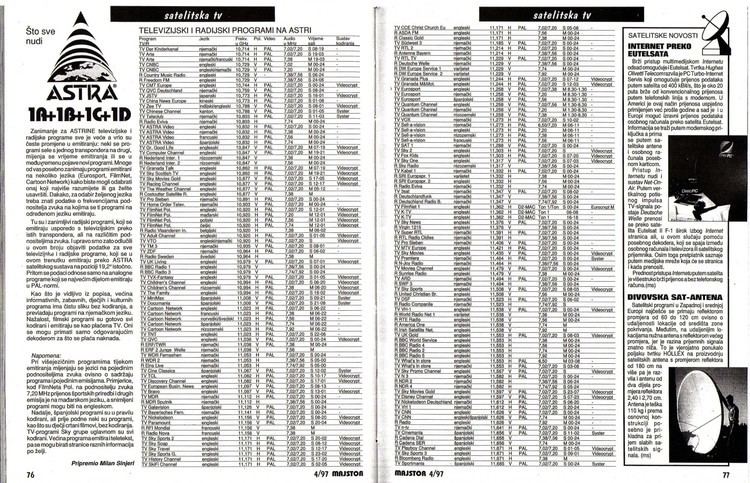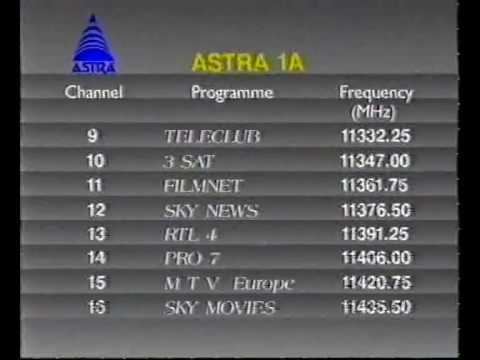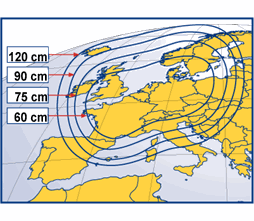Mission type Communication SATCAT № 19688 Launch date 11 December 1988 Inclination 11.77° Launch site Guiana Space Centre | Bus AS-4000 Inclination 11.77° Period 1 day | |
 | ||
Mission duration 12 years (planned)16 years (achieved) Launch mass 1,780 kilograms (3,920 lb) Manufacturer Lockheed Martin Space Systems Similar Astra 1C, Astra 1E, Astra 2A, Astra 3A, Astra 2C | ||
Astra 1a promotional video 1989
Astra 1A was the first satellite launched and operated by SES (Société Européenne des Satellites), launched in December 1988. During its early days, it was often referred to as the Astra Satellite, as SES only operated one satellite originally.
Contents
- Astra 1a promotional video 1989
- Astra 1a 1b satellite analog program lineup 1991
- Channels
- History
- Technical issues
- References

The satellite provided television coverage to Western Europe from 1989 through 2004 and was revolutionary as one of the first medium-powered satellites, allowing reception with smaller dishes than before.

Astra 1A was retired and became derelict in December 2004.
Astra 1a 1b satellite analog program lineup 1991
Channels

Among the channels carried in the early years after launch were the entire four channel Sky Television (later British Sky Broadcasting, after the merger with rival British Satellite Broadcasting on the Marcopolo satellite), the services consisted of Sky One/Sky Channel, Sky News, Sky Movies and Eurosport, the Scandinavian TV3 and TV1000, the German Pro7, Sat.1, RTL plus, 3sat and Teleclub, the Dutch RTL4 as well as FilmNet, Screensport, MTV Europe, The Children's Channel and Lifestyle.

Astra 1A began television broadcasts on February 5, 1989. Until 1998 all of SES' satellites were co-located with 1A at 19.2° east, leading that position to be known mostly as Astra 1 (later, Astra 19.2°E), although Astra 2C also used to operate there, before it moved to 28.2° east in autumn 2007.
History
The satellite came into its position on January 7, 1989. FilmNet became the first channel on the satellite when it launched on transponder 11 on February 1. Other channels such as Sky Channel, Eurosport, Sky News and Sky Movies from Sky Television, as well as the Scandinavian TV3 and MTV Europe all launched in February. The Children's Channel/Lifestyle and Screensport followed in March. The Scandinavian pay channel TV1000 launched in August 1989.
Sky Television had originally planned to launch The Disney Channel and Sky Arts on the Astra satellite in 1989, but these plans failed to materialize. The transponders intended for these channels, were used for Eurosport and the Dutch RTL Veronique (which would later become RTL4), respectively. The first German language programmes, RTL plus, Sat.1 and Pro 7 all launched on December 8. With the launch of 3sat in March 1990 and Teleclub in June all transponders were occupied.
Lifestyle was replaced by VOX in January 1993. Soon thereafter, Screensport merged with Eurosport and its transponder was replaced by RTL2. RTL 4 moved to Astra 1D in 1995 and was replaced by Super RTL. Teleclub was replaced by Kabel 1 during the same year. TV3 and TV1000 left Astra in 1996 and their transponders were taken over by BSkyB who used them for Fox Kids/Sky Two and Granada Plus/Granada Men & Motors. Filmnet also left in 1996, to be replaced by Bloomberg Germany in 1997.
BSkyB ended their analogue service in 2001, which meant that its services closed down. By the end of 2001, the satellite was moved from 19.2 degrees east to serve few years at 5.2 degrees east.
On 19.2 degrees east, the satellite was replaced by Astra 1F. Many channels, including RTL II, RTL, Eurosport, VOX, Sat.1, Kabel Eins, Super RTL and ProSieben were still broadcasting in analogue on the same frequencies in 2009.
In December 2004 Astra 1A was moved into a "Graveyard orbit" after some time at 5.2°E providing data services.
Technical issues
While never confirmed by SES, Astra 1A is believed to have experienced a number of technical problems throughout its lifetime, including overheating and power system anomalies. After the launch of Astra 1C in 1993, two transponders (4 and 15) were moved from 1A to 1C. Transponder 1 was also moved to Astra 1F after its launch, leaving 13 operational transponders on 1A in the late 1990s. Between February and April 1999, transponder 10 was also moved to 1F.
In mid-1999, the satellite experienced a loss of power which reduced its usable payload to 6 transponders. Transponders 3, 7, 8, 11, 12 and 16 remained on 1A while the others were transferred to 1F; 1C continued to carry 4 and 15 as before. Documentation provided by SES since this event stated the usable payload as 5/6 transponders.
